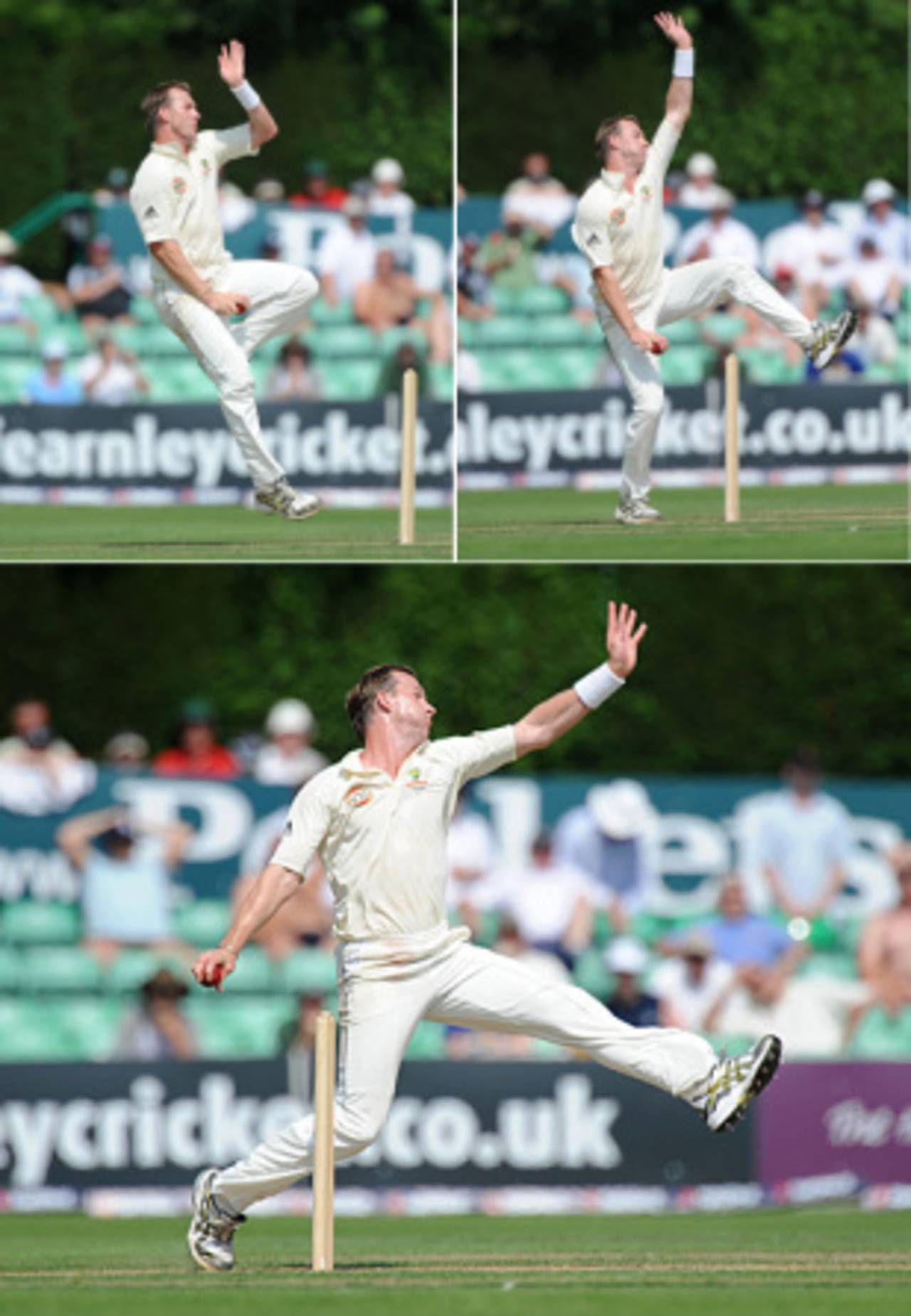Speed kills the fast bowler
Brett Lee's retirement marks another stage in the passing of a cricket species
Peter English
24-Feb-2010

Stages of strain: Fast bowlers slam up to 20 times their body weight on to their front foot in delivery • PA Photos
With Brett Lee's Test retirement the game has lost another of its endangered species. The fast bowler capable of lightning spells is dying even though the men who create the bolts are stronger and fitter than ever.
Lee, who could touch 160kph, rates Test cricket as the game's pinnacle but his body, wrecked by years of feet pounding into the ground and arms slinging balls, won't let him play over five days. What is sadder than the resignation in Lee's eyes is a fast-bowling landscape without high-speed, high-class quicks.
His withdrawal leaves Dale Steyn as the only experienced paceman who is currently fit. Steyn has just played his 38th Test, half the number Lee managed, which makes him the grandfather of the modern fast-bowling generation. At 33, he has been broken by the trade.
Cricket's joke is fast bowlers are stupid, but the crowded schedules have forced them to become increasingly clever - and business-orientated - in their outlooks. Lee is hoping his frame allows him to turn out in one-day internationals and Twenty20s, a specialist path already being taken by Shane Bond and Andrew Flintoff. Given the gruelling demands of Tests, bowlers cashing cheques that fly around like old-school bumpers seems the smart thing to do.
Lee has had five ankle operations, a couple of bouts of surgery on his right elbow, back stress fractures, side strains and stomach tears along with the other daily aches that are, comparatively, so minor they don't get reported to the physio. It's not something batsmen or spin bowlers have to endure.
Jason Gillespie and Dennis Lillee, who are among Australia's great fast men, have praised Lee for the way he dealt with so many setbacks and bowled through so much pain. Only they truly understand the demands of slamming up to 20 times their body weight on to the front foot at delivery, for overs and days in a row.
Since the start of the millennium, the declining Makhaya Ntini is the leading fast bowler with 380 wickets, but he wasn't in the Lee-Steyn league for pace. Lee leapt for 310 Test breakthroughs, with his first game coming at the very end of 1999, and is second on a decade list that is full of quality bowlers but has barely a sprinkling of extreme speed merchants.
Lee has had five ankle operations, a couple of bouts of surgery on his right elbow, back stress fractures, side strains and stomach tears along with the other daily aches that are, comparatively, so minor they don't get reported to the physio. It's not something batsmen or spin bowlers have to endure
Shoaib Akhtar, who has appeared in 46 Tests, now talks more about comebacks than making them and hasn't played a five-day game since 2007, the year Lasith Malinga was last used by Sri Lanka. Captains wanting containment add to the problems.
Bond becomes as brittle as a drought-hit tree when he has to bowl over consecutive days and Flintoff could be super fast in bursts, but only when his ankles, knees and shoulders stopped groaning. McGrath, Pollock, Zaheer, Gillespie and Harmison were fast-medium, while Vaas and Hoggard, who also feature high on the list, were more medium-fast.
Kemar Roach and Mohammad Aamer have just started learning about how hard quick bowling is after emerging over the past year, but both have already experienced the discomfort associated with operating at more than 150kph. Roach's ankle is already requiring painkilling treatment, while Aamer missed a Test against Australia due to a groin problem. Those types of injuries don't win sympathy, but Roach can ask Fidel Edwards, who is stuck on 43 Tests, about dealing with discomfort in the 2000s.
The astonishingly quick bowlers are loved because they are frightening and rare. With Lee's departure a genuine speedster has gone and left little apart from Steyn. It's easy to long for previous eras when bowlers seemed faster than they were probably were, which is an unqualified judgement from a comfy spectator's seat.
In the 1990s, Ambrose, Walsh, Donald, Waqar and a young McGrath had more than 250 Test wickets for the decade. Marshall, Hadlee, Kapil, Imran and Botham achieved that mark in the 10 years before. They were greats, varying between fast-medium and flat-out, who operated on a diet of fewer matches and no lucrative Twenty20 distractions.
Australia's next long-term bowling hope is Mitchell Johnson, who hasn't missed a match in 32 Tests since his debut, but he's not super fast. Currently he is the third quickest bowler in Australia's Twenty20 team, behind Shaun Tait, who reached 160.7kph against Pakistan, and Dirk Nannes, who is regularly in the 150s.
Tait doesn't want to play Tests and early this week Nannes retired from first-class action. The longer game is just too hard and they get injured too often, which costs international caps and threatens IPL deals. Four overs at full throttle is the new dream, not 20 overs a day of grunt during two innings of a Test. Over the next couple of months Lee's creaking body will tell him if he can cope with even such a small amount of work.
Peter English is the Australasia editor of Cricinfo